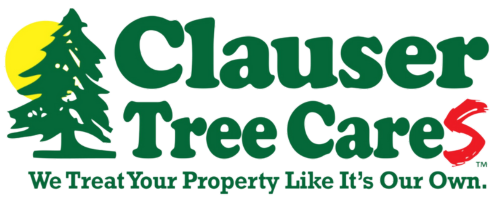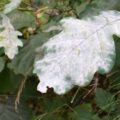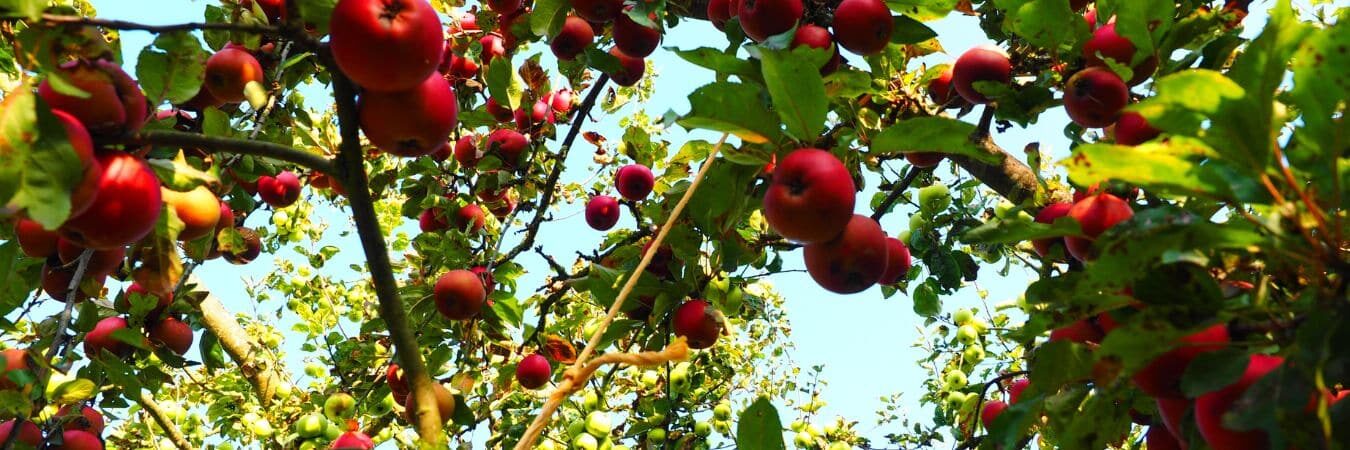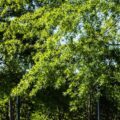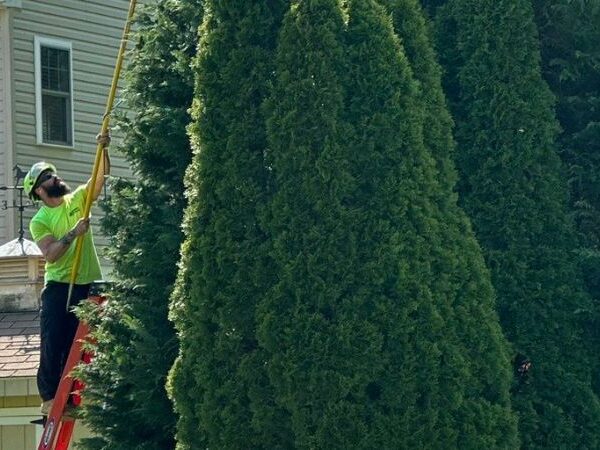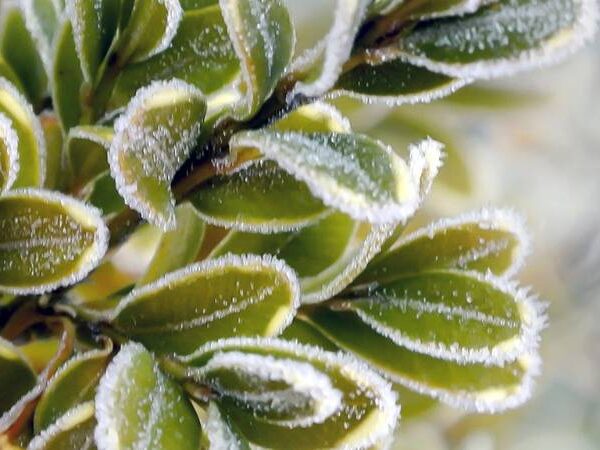Ever glanced at a gnarled branch hanging precariously over your roof, or felt a shiver as a towering oak swayed ominously in the wind? Wondered if that dying ash tree is a hazard, or how to tell if that glorious silver maple is dangerous? You’re not alone. Countless homeowners across eastern Pennsylvania grapple with the fear of hazardous trees lurking in their yard.
This comprehensive guide answers all your burning questions about dangerous trees in Eastern Pennsylvania. From identifying hidden threats like structural weaknesses and destructive diseases, to navigating the legalities of hazard tree removal, we’ll equip you with the knowledge and resources to ensure your home remains one of peace, not peril.
Dive in and discover how to keep your home, your family, and your trees thriving… safely!
In This Guide
- How to identify and assess trees for hidden hazards
- Your potential liability for dangerous trees
- Staying safe around hazardous trees
- Hazard tree removal
- Preventing trees from becoming unsafe
- What to do if you have a dangerous tree
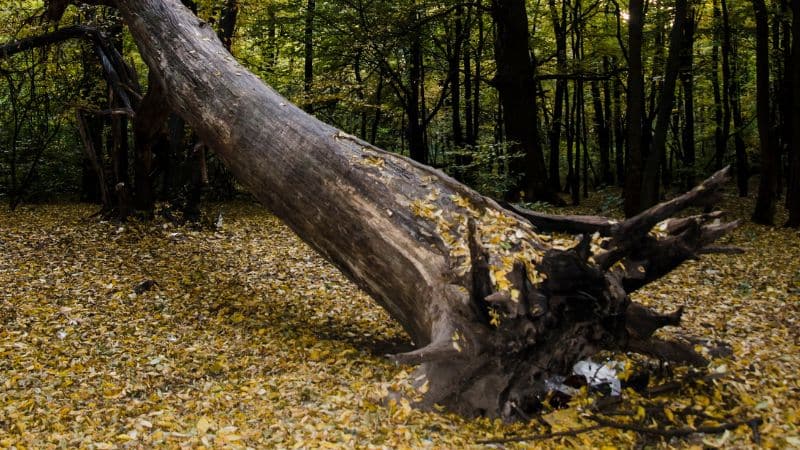
How to Identify & Assess Trees for Hidden Dangers
What is a hazard tree?
A tree is called a hazard tree when it has structural defects in the roots, trunk, or branches that may cause the tree or tree part to fail, posing a risk of property damage or personal injury. Hazard trees have a defect that makes them predisposed to failure and are located in a way that presents a threat of property damage, personal injury, or fatality in the event of a failure.
It’s important to note that not all trees with imperfections are hazards. It’s the combination of the risk of failure and the potential for damage that determines a tree’s hazard status.
How do I know if a tree on my property is a hazard?
There are several signs that may indicate a tree on your property is a potential hazard:
- Cracks or fissures in the trunk or branches: These can weaken the tree’s structure and make it more likely to break or fall.
- Dead or dying branches: Dead branches can easily fall and cause damage or injury.
- Hanging or broken branches: Broken or cracked branches hanging in the tree canopy are called “widow makers” for a reason; they can fall without warning and severely injure anyone below.
- Leaning or tilting: A tree that is leaning significantly off-center could fall, especially during strong winds or heavy snow.
- Mushrooms or conks growing on the trunk or roots: The presence of mushrooms and conks growing on the bark of trees or on exposed roots can indicate root rot or wood decay. As decay progresses, the wood weakens, making failure more likely.
- Visible insect infestation: Look for signs of carpenter ants, termites, or other wood-boring insects, which can damage the tree’s structure.
- Unusual foliage loss or discoloration: This could be a sign of disease or stress, which can weaken the tree.
- Damage to the root system: Exposed roots, cracks in the soil around the base of the tree, or uneven settling of the ground can all indicate root problems that could make the tree unstable.
- History of falling branches or limbs: If a tree has a history of shedding branches, especially large ones, it is more likely to do so again in the future.
- Proximity to power lines or structures: Trees that are close to power lines or buildings pose a risk of falling onto them and causing damage or injury.
- Rapid growth or abnormal branching: Trees that are growing too quickly or have unusual branching patterns may be structurally weak.
For more details, see 7 Signs of a Dangerous Tree.
Should I hire an arborist or a tree removal company to assess my trees?
If you are concerned about the safety of a tree on your property, it is always best to err on the side of caution and consult with a professional. An arborist is a trained tree care specialist who can assess the health and stability of your trees and recommend the best course of action. They can also provide valuable information about the specific risks posed by your trees and how to mitigate them.
While a tree removal company can assess your trees for removal purposes, an arborist will offer a more comprehensive assessment considering the tree’s health, potential for preservation, and alternative solutions besides removal.
What factors contribute to a tree becoming dangerous?
Several factors can contribute to a tree becoming dangerous, including:
- Age: Older trees are more likely to have structural weaknesses and decay.
- History of disease: Fungal or bacterial diseases can weaken the tree’s structure and make it more susceptible to falling.
- Insect infestation: Insects such as carpenter ants and termites can damage the tree’s internal structure.
- Weather damage: Storms, high winds, and heavy snow can all damage trees and make them more likely to fall.
- Improper planting or care: Trees that are planted improperly, are too close to buildings or power lines, or that are not properly pruned, are more likely to become hazards.
Does the location of a tree impact its risk potential?
The location of a tree can significantly impact its risk potential. Trees that are close to power lines, buildings, roads, or other structures pose a greater danger if they fall. The more frequently people are in the vicinity of the tree and the greater the number of people, the greater the hazard. Trees that are located on a slope or in an area with poor drainage are also more likely to pose a risk.
Your Potential Liability for Dangerous Trees
Who is responsible for a tree that falls and causes damage?
In Pennsylvania, legal responsibility for a tree falling and causing damage depends on several factors, including:
- Ownership of the tree: The owner of the tree is generally responsible for any damage it causes if it falls due to neglect or lack of proper maintenance.
- Knowledge of the hazard: If someone knew or should have known that the tree was a hazard and failed to take reasonable steps to address it, they may be held liable for any resulting damage.
- Contributory negligence: If the person who suffered damage also contributed to it by, for example, parking a car under a clearly hazardous tree, they may be partially responsible for the damage.
Does my homeowner’s insurance cover damage caused by a hazardous tree?
Most homeowner’s insurance policies in Pennsylvania will cover damage caused by falling trees and tree part, but there are some exceptions. Check your specific policy carefully to see if there are any exclusions or limitations. Some things to look for include:
- Coverage for “dwelling” vs. “other structures”: Some policies may only cover damage to your house, not detached structures like sheds or garages.
- Deductible for tree-related damage: Your policy may have a separate deductible for tree-related claims.
- Exclusions for specific tree conditions: Some policies may exclude coverage for damage caused by trees that were already dead or dying, or that were known to be hazardous.
What are the legal ramifications of not addressing a dangerous tree on my property?
If you know or should have known that a tree on your property is a hazard and fail to take reasonable steps to address it, you could be held liable for any damage it causes. This could include damage to property, injury to people, or even wrongful death. Additionally, local ordinances may impose fines or penalties for failing to maintain your trees in a safe condition.
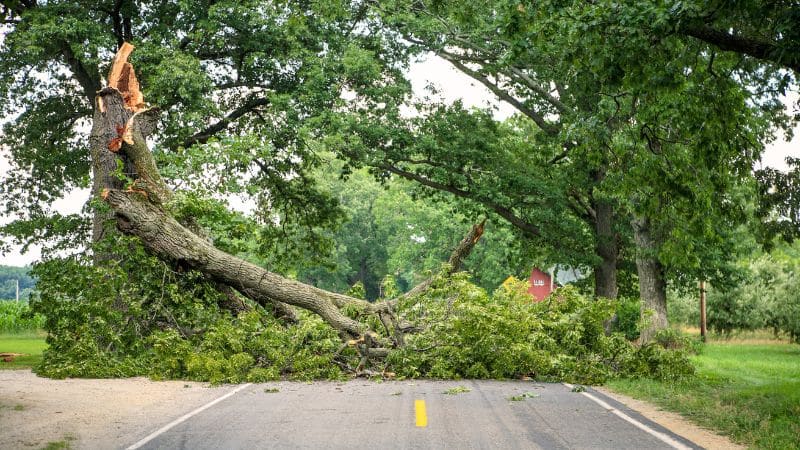
Staying Safe Around Hazardous Trees
Which tree species in eastern Pennsylvania are most likely to become a hazard?
In eastern Pennsylvania, certain tree species are more likely to become hazardous due to factors like their growth patterns, susceptibility to diseases, and the region’s climate.
- Silver Maple (Acer saccharinum): Known for its fast growth and weak wood, silver maples can be prone to breakage, especially during storms.
- Bradford Pear (Pyrus calleryana ‘Bradford’): Although popular for their flowers, these trees have a weak branch structure and are known to split apart.
- Willows (Salix spp.): Willow trees have brittle wood and shallow root systems, making them susceptible to wind damage and uprooting.
- Norway Maple (Acer platanoides): This invasive species has shallow roots that can damage sidewalks and foundations. It’s also prone to branch breakage.
- Eastern White Pine (Pinus strobus): While generally sturdy, white pines can be prone to breakage under the weight of heavy snow or ice, as well as high winds.
- Ash (Fraxinus spp.): Ash trees are at high risk due to the emerald ash borer, an invasive beetle that has decimated ash populations.
- Poplars (Populus spp.): Poplars, including cottonwoods, grow rapidly but have weak wood that can break easily.
What safety precautions should I take if I have a dangerous tree on my property?
If you have a dangerous tree on your property, it is important to take immediate steps to protect yourself and others. Here are some safety precautions you can take:
- Post warning signs around the base of the tree warning people of the danger.
- Limit access to the area and keep children and pets away from the tree.
- Contact a qualified arborist to assess the tree and recommend the best course of action.
- Do not attempt to remove the tree yourself! Tree removal is a dangerous job that should be left to professionals.
It is always better to be safe than sorry when it comes to dangerous trees. Taking proactive steps to address the problem can help you avoid costly damage and potential legal liability.
What should I do about a tree with large branches hanging over my house?
If you have a tree with large branches hanging over your house, it is important to take action to address the situation. Here are a few options:
- Have the branches pruned: A qualified arborist can safely remove the branches that are overhanging your house.
- Have the entire tree removed: If the branches are too large or numerous to prune safely without unbalancing the tree, or if the tree is otherwise in poor condition, it may be best to have it removed entirely.
- Install support cables: In some cases, it may be possible to install support cables to help stabilize the branches and prevent them from breaking.
It is important to consult with a qualified arborist to determine the best course of action for your specific situation.
Are trees near power lines a safety hazard?
Yes, trees near power lines can be a safety hazard if they come into contact with the lines, causing outages or even electrical fires. The specific level of risk depends on several factors, including:
- Distance of the tree from the power lines: Trees that are very close to power lines (generally within 10-15 feet) pose a greater risk than trees that are further away.
- Size and species of the tree: Taller trees and those with large branches are more likely to reach power lines.
- Weather conditions: High winds, heavy snow, or ice storms can increase the risk of branches breaking and hitting power lines.
If you have a tree near power lines, contact your utility company and ask them to assess the situation and determine whether the tree needs to be trimmed or removed. Do not attempt to trim or remove the tree yourself, as this could be very dangerous.
Can a healthy tree become dangerous due to weather events like storms or heavy snowfall?
Yes, even a healthy tree can become dangerous due to weather events like storms or heavy snowfall. Here are some ways weather can impact trees:
- High winds: Strong winds can cause branches to break or the entire tree to blow over.
- Heavy snow or ice: The weight of snow and ice can accumulate on branches, causing them to break or the tree to topple.
- Lightning: Lightning strikes can damage or weaken trees, making them more likely to fall.
If you live in an area prone to severe weather, you should have your trees regularly inspected by a qualified arborist. They can identify any potential weaknesses that could make the tree more susceptible to storm damage.
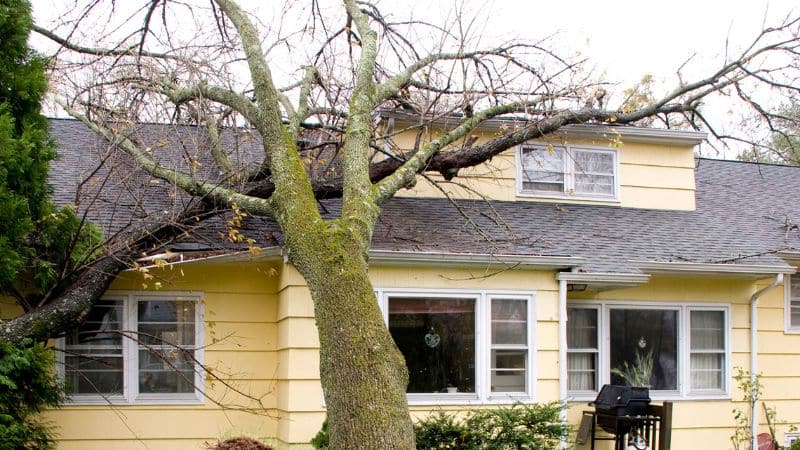
Hazard Tree Removal
What permits or approvals do I need before removing a dangerous tree?
In Pennsylvania, you may need to obtain a permit before removing a tree, depending on the size and location of the tree. Here are some general guidelines:
- Trees with a diameter of 6 inches or more at chest height: You will likely need a permit to remove these trees, regardless of their location.
- Trees located within a certain distance of power lines: You will need a permit from the utility company before removing these trees.
- Trees located in historic districts or protected areas: You may need a permit from the local government before removing these trees.
It is always best to check with your local municipality or township to determine what permits or approvals are required before removing a tree.
Can I cut down a dangerous tree myself, or should I always hire a professional?
While it is technically possible to cut down a dangerous tree yourself, it is strongly recommended that you hire a professional tree removal company for several reasons:
- Safety: Tree removal can be dangerous, especially if the tree is large, dead, or diseased. Professional arborists have the training and equipment to safely remove trees without putting themselves or others at risk.
- Insurance: Most homeowner’s insurance policies will not cover damage caused by tree removal if you do it yourself.
- Liability: If you remove a tree yourself and it causes damage or injury, you could be held liable.
- Proper disposal: Professionals know how to properly dispose of tree debris, which can be a complex process.
Hiring a professional tree removal company like Clauser Tree Care will give you peace of mind knowing that the job will be done safely and correctly.
How dangerous are dead or dying trees?
Dead or dying trees are more dangerous than healthy trees for several reasons:
- Structural weakness: Dead trees have lost their internal moisture, making them brittle and more likely to break or fall.
- Branch decay: Dead branches can easily fall and cause damage or injury.
- Insect infestation: Dead trees are more attractive to insects, such as carpenter ants and termites, which can further weaken the tree.
- Unpredictable behavior: Dead trees can fall in unpredictable directions, making them even more dangerous.
If you have a dead or dying tree on your property, it is important to have it removed as soon as possible to avoid any potential risks.
Preventing Trees from Becoming Unsafe
How can I prevent trees from becoming hazards in the future?
There are several steps you can take to prevent trees from becoming hazards in the future:
- Regular inspections: Have a qualified arborist inspect your trees every 2-3 years to identify any potential problems early on.
- Proper planting: When planting new trees, choose appropriate species suitable for your climate and location, and ensure they’re planted with proper spacing and care.
- Prune regularly: Regular and proper pruning can remove weak or dead branches, improve tree structure, and allow better light penetration, reducing stress and promoting healthy growth.
- Water and fertilize properly: Provide adequate water and fertilizer for your trees to maintain their health and strength.
- Address damage promptly: If you notice any damage to your trees, such as insect infestation, disease, or storm damage, address it promptly to prevent further deterioration.
By following these proactive measures, you can significantly reduce the risk of your trees becoming hazards and keep them healthy and beautiful for years to come.
Can a dangerous tree be saved with pruning or cabling and bracing?
Not all dangerous trees can be saved with pruning or structural support, but it’s often a viable option depending on the specific situation. Here are some factors to consider:
- Severity of the problem: Pruning and bracing are typically effective for addressing minor issues like weak branches, insect damage, or minor decay. However, for severely compromised trees with major structural issues, removal may be the only safe option.
- Species and condition of the tree: Certain tree species respond better to pruning and bracing than others. Additionally, a healthy tree with a relatively minor problem will have a higher chance of successful treatment compared to a weak or diseased tree.
- Cost and feasibility: Pruning and bracing can be costly, especially for large trees. Additionally, depending on the location and accessibility of the tree, it may not be practical or safe to perform these procedures.
If you’re unsure whether your tree can be saved, consult a qualified arborist. They can assess the specific issue, the overall health of the tree, and recommend the best course of action, including pruning, bracing, or removal.
Who do I contact if I have concerns about a potentially dangerous tree in my neighborhood?
If you have concerns about a potentially dangerous tree in your neighborhood, you can contact several entities depending on the situation:
- Local municipality or township: Most municipalities have departments or officials responsible for maintaining public trees and addressing potential hazards.
- Property owner: If the tree is on private property, it’s ultimately the owner’s responsibility to address any potential danger. You can politely talk to the owner about your concerns and suggest they consult with an arborist.
- Utility company: If the tree is near power lines or other utilities, contact the respective utility company. They will assess the situation and determine if the tree poses a risk to their infrastructure. In some cases, the city or utility company may intervene if a hazardous tree poses a threat to public safety or infrastructure.
Taking action to address a potentially dangerous tree, whether on your property or in your neighborhood, can help prevent accidents and ensure the safety of your community.
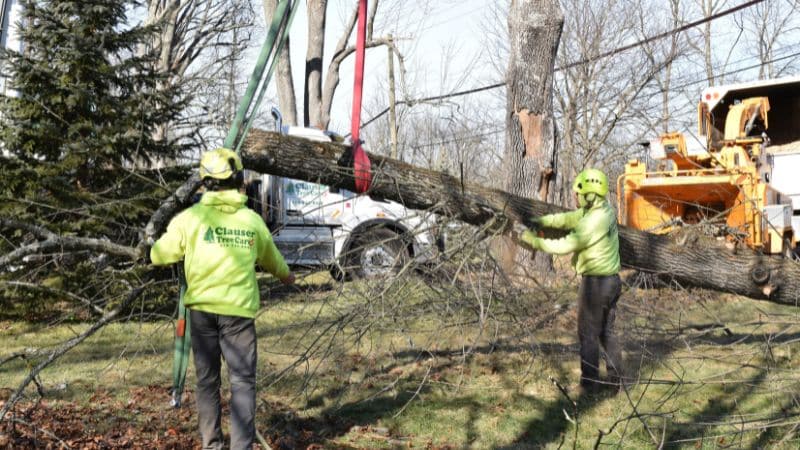
Concerned About a Dangerous Tree? Call Clauser Tree Care!
If you suspect a tree poses a risk to your home, neighbors, or family, do not put off getting a professional arborist evaluation of the tree’s health and potential hazards! Timely action can mean the difference between peace of mind and an unnecessary and costly accident.
We also recommend regular tree inspections to identify potential issues early. This allows us to provide physical support for weak branches and stems, apply treatments to prevent or control diseases and insect infestations, prune deadwood and damaged branches, and much more. Scheduling dependable tree care services regularly can help prevent disease, structural defects, and obstructive growth, greatly reducing the risk of hazards.
For immediate response to dangerous tree situations and arborist evaluations to prevent tree hazards, call the professionals at Clauser Tree Care at 215-542-8291. We’re here to keep you safe!
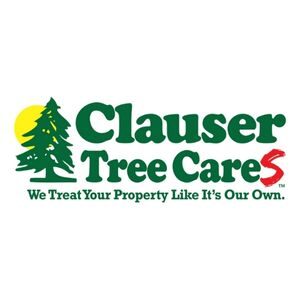
About Clauser Tree Care
From who you talk to on the phone in our office, to our courteous and experienced work crews who provide your service, all of the hard-working team members at Clauser Tree Care strive for complete client satisfaction. Our job is simply not done until you are pleased with the experience that you have had working with our company. Founded more than 25 years ago on the principles of honest work and arboricultural best practices, we strive for a higher standard of care for a greener future.
